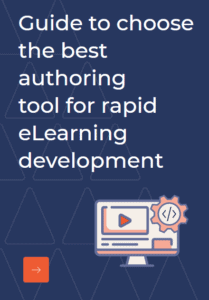It is said that any significant change starts from a question. A question that forces the thought towards really great solutions- experiments and iterations included. In most cases it starts with 'why'. As far as eLearning is concerned it has been long established that it increases the ROI, increases retention, makes learning/training easier and flexible and also increases the global reach. But, are those reasons enough to jump onto the eLearning bandwagon?
Yes, and No. Confusing right? Well, the answer lies in the question - Doesn't your organization have to be ready first? The L&D’s enthusiasm cannot be the only driving force behind switching to eLearning. Assessment of the various organizational factors is the key aspect. For learning developers an eLearning starts from Analysis, and for the organization that is getting started with eLearning the crucial step is 'Need Analysis'. And how do you do that? Different researchers have given different theories on doing so. For Instance, Samantha Chapnick's Readiness model that gives us 8 categories to analyze an organization’s eLearning Readiness namely: Psychological readiness, Sociological readiness, Environmental Readiness, Human Resource Readiness, Financial readiness, Technological Skill Readiness, Equipment Readiness, and Content Readiness.
For many of us this might seem really complex to understand and implement. Why not simplify it? If complex theories are not what you need, here are some interesting questions that you might want start with.
- Does your Organization Have Training Requirements?
This might sound like a no brainer, but it is essentially the question isn't it? For, organizations with no training requirements- where does eLearning even fit in, let alone be relevant. But, it's essentially the time to reconsider the overall outlook, and time for such organizations to start thinking about some sort of learning and development strategy for their existing employees. - What are the Current Modes of Training?
This comes as a part of analyzing the current training strategy. If yours' is an organization considering the move to eLearning, we can safely assume that the existing mode of training is essentially classroom-based and Instructor-led. But, there can be scenarios where learning videos are used within classroom-training too. In such cases, it becomes more about transitioning into a complete eLearning system, with more of self-paced, social-collaborative learning, tracking-LMS system etc. - How do you Plan on using eLearning?
This is more so to understand what kind of outcomes you/your organization expects from an eLearning strategy. The kind of benefits you wish to attain. Is it just in terms of ROI, or overall development? Also, what kind of devices are you thinking of, will it be suitable for the organization, what kind of learning models can be used. Is blended learning an option too. It's a long line of sub-questions that will follow. - Will eLearning Assist in the Organization's Long-term Development Plans?
This is can be by far the most important question from an organizational perspective. What does an organization gain? Increased performance-production-retention-growth-expansion? If introduction of eLearning tends to impact any of these, then just go ahead. - Are all the Stakeholders Ready for Such a Change?
Having all the stakeholders - the L&D, higher management, the learners, the subject experts, the trainers, stockholders etc. on the same page is essential before switching to eLearning. Without this the chances of failure can be really high, as eLearning is a cost-time inclusive process and issues in midway can bring about huge losses. - How Ready are the Learners?
Though essentially the part of stakeholders just the mental readiness of the learners doesn’t suffice. They have to be technologically aware and ready to adapt to the latest changes. The bottom line is; you wouldn’t want your learners reacting to eLearning the way Captain America did to technology after being thawed out from Ice (pun intended). - Are you Ready Financially?
Here comes the real deal. After all, 'Money Matters'. So, even if you have Physio-socio-environmental readiness, the fact that eLearning costs cannot be ignored. Be it in-house or outsourced, everything from design to development has costs involved, that can be negotiated but can't be written away. - Do you have the Infrastructural Capacity?
If the finances are in place, the next thing to check is the existing infrastructure. If you have been considering eLearning on desktops- then find out how many you have at present- analyze whether those will suffice. If not think about how the training will be managed- how many more devices you will need- the cost associated and not just that the softwares you may have to purchase.
Once all these questions are answered, and you decide on going with eLearning there still is one critical question that remains. What about the Content? Content creation can either be outsourced, or created in-house. For the former - you need to find the right vendor and have the finances sorted. For the latter you need expertise, softwares, infrastructure and finance to consider.
So, ask the questions, find out if your organization is ready for the shift. The whole world has been going Gaga about eLearning for over a decade now, and many organizations have reaped huge benefits too. So, why wait any longer - Better Late than Never!
Knowzies highly expert eLearning consulting team helps many such clients to find answers to these questions. If you have got one, you can contact us @ info@www.knowzies.com



